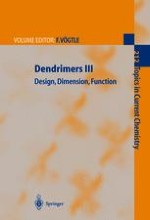2001 | OriginalPaper | Chapter
Dendrimer-Encapsulated Metals and Semiconductors: Synthesis, Characterization, and Applications
Authors : Richard M. Crooks, Buford I. Lemon III, Li Sun, Lee K. Yeung, Mingqi Zhao
Published in: Dendrimers III
Publisher: Springer Berlin Heidelberg
Included in: Professional Book Archive
Activate our intelligent search to find suitable subject content or patents.
Select sections of text to find matching patents with Artificial Intelligence. powered by
Select sections of text to find additional relevant content using AI-assisted search. powered by
This chapter describes composite materials composed of dendrimers and metals or semiconductors. Three types of dendrimer/metal-ion composites are discussed: dendrimers containing structural metal ions, nonstructural exterior metal ions, and nonstructural interior metal ions. Nonstructural interior metal ions can be reduced to yield dendrimer-encapsulated metal and semiconductor nanoparticles. These materials are the principal focus of this chapter. Poly(amidoamine) (PAMAM) and poly(propylene imine) dendrimers, which are the two commercially available families of dendrimers, are in many cases monodisperse in size. Accordingly, they have a generation-dependent number of interior tertiary amines. These are able to complex a range of metal ions including Cu2+, Pd2+, and Pt2+. The maximum number of metal ions that can be sorbed within the dendrimer interior depends on the metal ion, the dendrimer type, and the dendrimer generation. For example, a generation six PAMAM dendrimer can contain up to 64 Cu2+ ions. Nonstructural interior ions can be chemically reduced to yield dendrimer-encapsulated metal nanoparticles. Because each dendrimer contains a specific number of ions, the resulting metal nanoparticles are in many cases of nearly monodisperse size. Nanoparticles within dendrimers are stabilized by the dendrimer framework; that is, the dendrimer first acts as a molecular template to prepare the metal nanoparticles and then as a stabilizer to prevent agglomeration. These composites are useful for a range of catalytic applications including hydrogenations and Heck chemistry. The unique properties of the interior dendrimer microenvironment can result in formation of products not observed in the absence of the dendrimer. Moreover the exterior dendrimer branches act as a selective gate that controls access to the interior nanoparticle, which results in selective catalysis. In addition to single-metal nanoparticles, it is also possible to prepare bimetallic nanoclusters and dendrimer-encapsulated semiconductor nanoparticles, such as CdS, using this same general approach.
